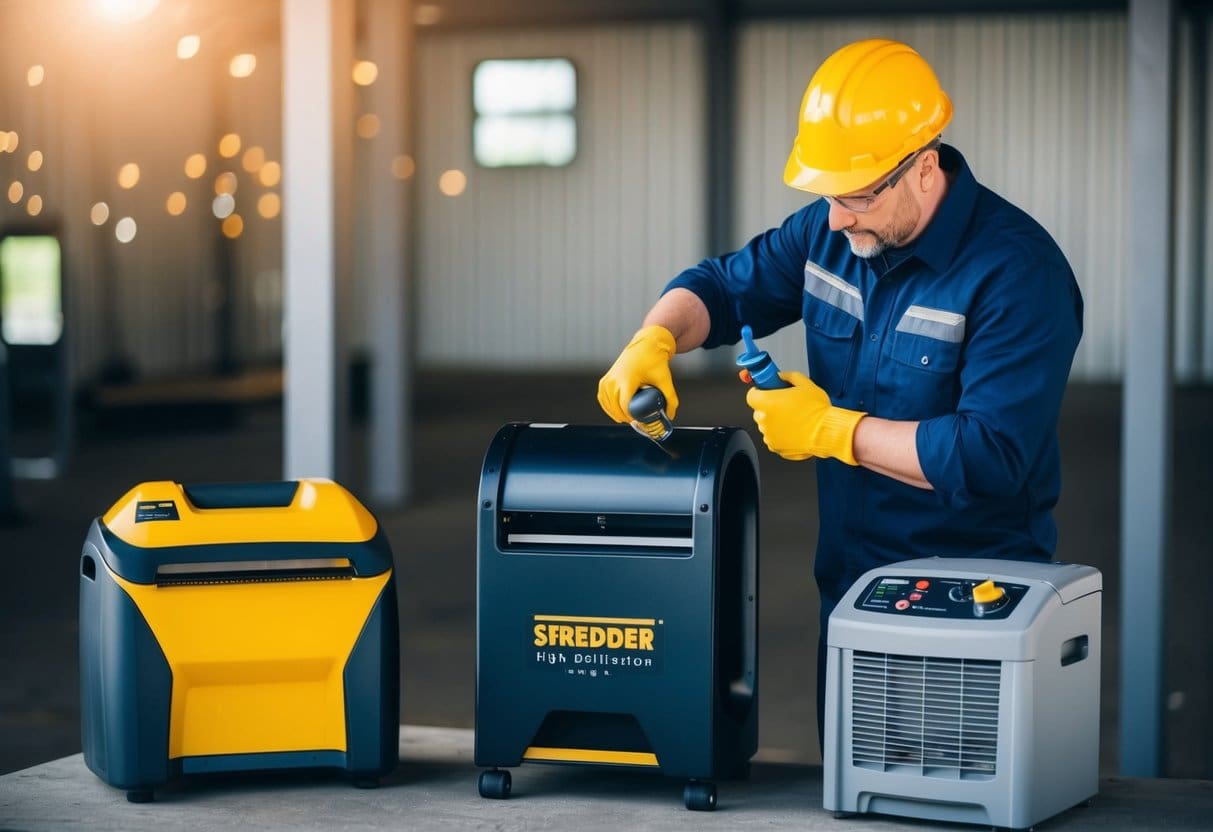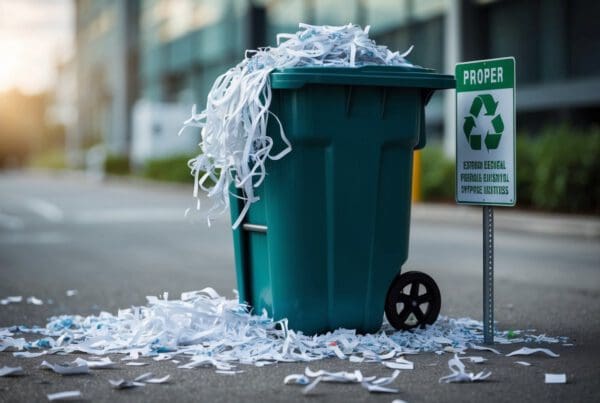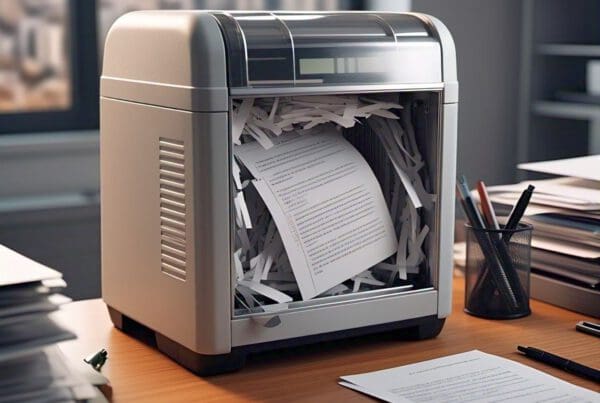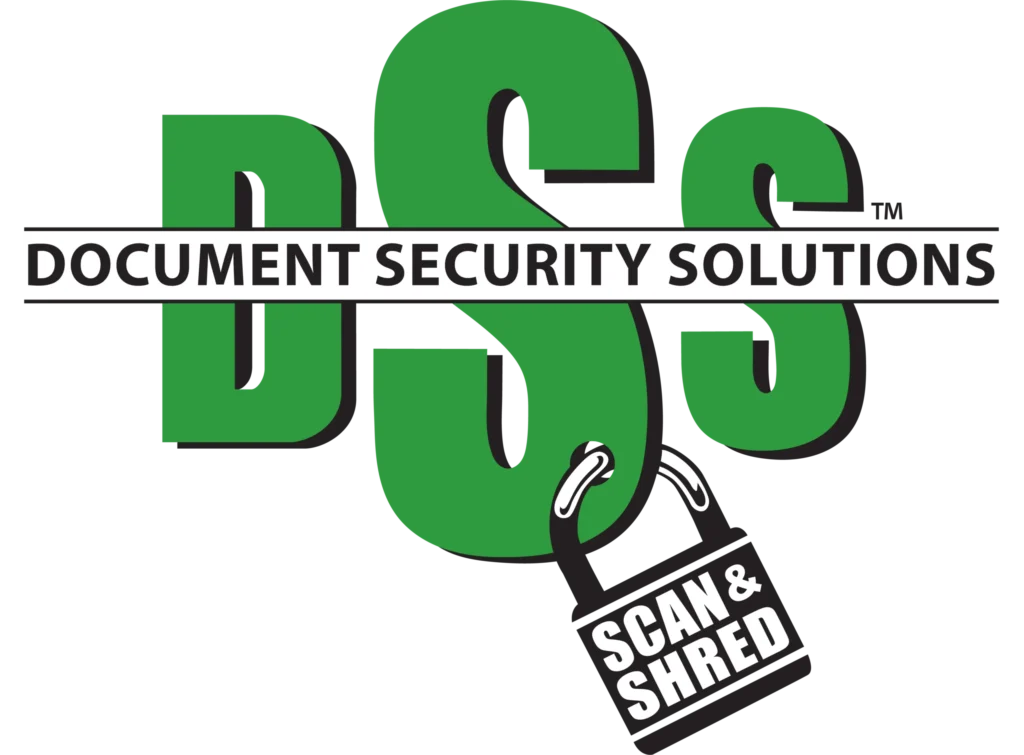Shredder Safety and Maintenance
Ensuring safety when using shredders involves understanding risks and maintaining equipment. Following the manufacturer’s guidelines is crucial for safe operation. Regular maintenance can prevent issues and enhance the shredder’s lifespan.
Identifying Safety Risks with Shredder Use
Shredders come with various safety features, yet risks remain. Finger injuries are common if hands are too close to the blades. Loose clothing and long hair can also pose a danger if they get caught.
To prevent accidents, we must use shredders as intended. Overloading paper slots can cause jams or damage. It’s essential to be aware of surroundings while shredding to avoid potential hazards.
Recognize the signs of wear, like increased noise or overheating. These can indicate potential safety issues, requiring prompt attention or repairs.
Adhering to Manufacturer’s Guidelines for Safe Operation
The user manual offers critical safety and operation details. It frequently includes information on installation, safe operation, and troubleshooting. We must follow these guidelines carefully to avoid dangers and ensure efficient use.
Manufacturers often list specific shredding capacities and materials that their machine can handle. Ignoring these limitations might damage the shredder or cause injury.
Some shredders have built-in safety features like automatic shut-off or anti-jam technology. Understand these features to maximize safety. This means reading and following the user manual closely.
Implementing Regular Maintenance Schedules
Regular shredder maintenance increases safety and durability. By scheduling maintenance, we can prevent many potential problems. Regular checks should include lubrication of blades using oil sheets or lubricants. This keeps the machine running smoothly and efficiently.
Debris buildup in the blades is another common issue. Regular cleaning prevents clogs and overheating. A simple schedule for clearing the shredder bin and ensuring there’s no paper stuck is efficient.
Some parts may require replacement over time, such as sensors or blades. Monitoring these components and replacing them when necessary helps maintain high performance and safety standards.
Recognizing Signs of Shredder Inefficiency
Our shredder might show signs of inefficiency that can impact its performance. These signs include frequent paper jams, increased noise, and overheating. It’s important for us to recognize these issues so we can maintain operational efficiency.
Dealing with Frequent Paper Jams
Frequent paper jams can be a sign that our shredder isn’t working well. When this happens, we might need to look at the type of paper used or the amount fed into the shredder at once.
To reduce jams, we can try feeding fewer sheets at a time or checking if the paper is crumpled. Regular maintenance, like oiling the blades, can also help. Consult the shredder’s manual for troubleshooting advice. Regular cleaning can prevent small paper pieces from building up and causing problems.
Noticing Increased Noise During Operation
Increased noise can indicate something isn’t right with our shredder. If we hear grinding or rattling sounds, this might mean parts are wearing out or need to be lubricated.
Checking for loose or misaligned parts could solve the problem. Regular maintenance, like tightening screws and bolts, can help keep the shredder quieter. Listen carefully for unusual sounds, as they often point to issues that may need fixing.
Responding to Overheating Issues
Overheating is a serious problem and could cause the shredder to shut down. This usually happens when it’s used beyond its recommended capacity or for extended periods.
To prevent overheating, we should follow the shredder’s duty cycle instructions. Allowing the shredder to cool down after heavy use helps a lot. Make sure the shredder isn’t placed in a hot environment. Check airflow around the machine to ensure proper ventilation.
By paying attention to these signs, we can address shredding issues early and keep our shredder running smoothly.
Evaluating Shredder Capacity and Productivity

Choosing the right shredder depends on productivity needs and business volume. A small office might need a basic shredder, while larger businesses may benefit from industrial models. We will explore matching capacity with needs and when to consider industrial options.
Matching Office Shredder Capacity with Business Needs
For most offices, a standard shredder suits everyday needs. We need to consider how many sheets it can shred at once and its shredding speed. Shredders with higher capacity save time, which can boost office productivity.
Think about the volume of sensitive documents processed weekly. A small team may only need a machine handling up to 10 sheets per pass, whereas larger teams might require shredders processing 20 or more sheets. It’s useful to regularly evaluate the machine’s capacity to ensure it meets evolving demands. Regular maintenance also extends the shredder’s life and keeps it running smoothly.
Determining When to Invest in an Industrial Shredder for Heavy-Duty Use
Industrial shredders benefit businesses with heavy shredding loads. If we frequently deal with large volumes of paper, these machines offer efficiency and power. Industrial machines can handle thousands of sheets daily, cutting down on shredding time significantly.
Businesses that require continuous shredding throughout the day should consider these machines. They handle a variety of materials, not just paper, which adds versatility. The ability to shred CDs, credit cards, and more, makes them ideal for environments needing secure disposal of diverse items. When we notice that standard shredders can’t keep up with the workload or are frequently overheating, it’s time to think about upgrading to an industrial shredder.
Addressing Potential Fire Hazards
We need to pay close attention to factors that might introduce fire risks when using shredder machines. Proper practices and key safety features play vital roles in reducing these risks.
Preventing Fire Risks with Proper Shredder Practices
To avoid fire hazards, we should regularly maintain our shredder machines. Regular cleaning reduces the chances of paper jams and overheating. It’s important to allow cooling periods during heavy usage, preventing the machine from overheating and potentially igniting paper debris.
Avoiding improper use is crucial. Only shred materials meant for our specific shredder model. Overloading can stress the motor and create excessive heat.
Recommended Safety Features to Mitigate Fire Hazards
Modern shredders come with essential safety features to prevent fires. A thermal protection switch automatically shuts off the shredder if it starts overheating. This feature can save our machine from damage and risk.
Another useful feature is a jam-proof system. It helps minimize paper jams, which can cause overheating. Some machines have indicator lights that alert us when they require attention, increasing safety during operation.
With these practices and features, we can safely use our shredder machines without the worry of fire hazards.





